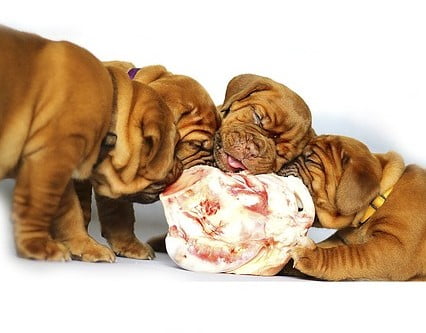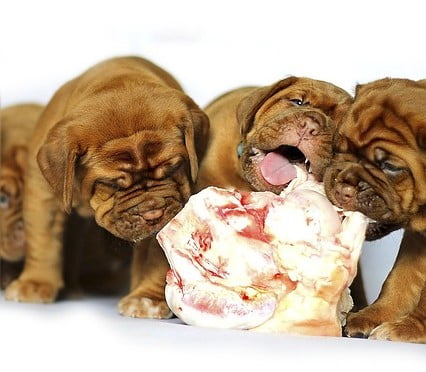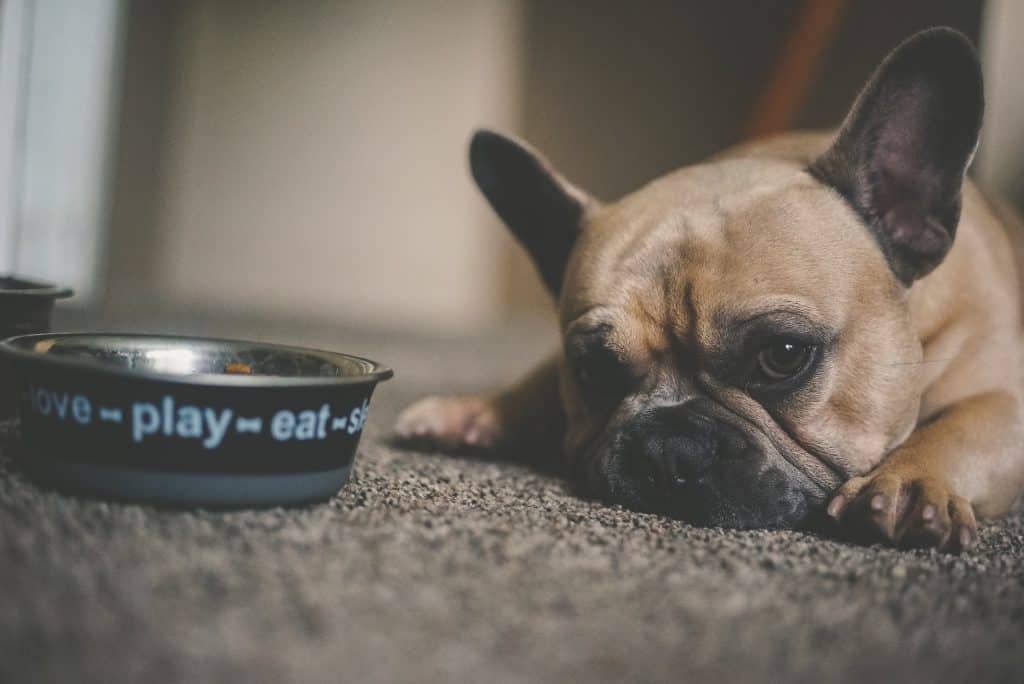Bringing a furry bundle of joy into your home is an exciting experience, and ensuring their proper nutrition is crucial for their healthy development. Raw food diets have gained popularity among pet owners in recent years as they provide a more natural and nutrient-rich alternative to processed kibble. However, determining how much raw food to feed a puppy can be daunting. In this article, we’ll guide you through the essential considerations and provide a helpful framework for determining how much raw food to feed your puppy.
Understanding the Raw Food Diet
Raw food diets typically consist of uncooked meats, bones, organs, fruits, and vegetables, mimicking a dog’s ancestral diet. This species-appropriate approach can provide numerous benefits, including improved digestion, healthier coat, increased energy, and stronger immune function. However, it’s crucial to balance and ensure your puppy receives the right nutrients.

Benefits of Raw Food for Puppies
Feeding puppies a raw food diet can offer several potential benefits for their overall health and well-being. Here are some of the benefits associated with a raw food diet for puppies:
- Nutritional Value: Raw food diets for puppies typically include a variety of fresh, unprocessed ingredients such as raw meat, bones, organs, fruits, and vegetables. These whole foods provide essential nutrients, including proteins, healthy fats, vitamins, minerals, and enzymes in their natural form, which can support optimal growth and development.
- Improved Digestion: The natural enzymes present in raw food can aid in the digestion and absorption of nutrients for puppies. Raw diets are often free from additives, fillers, and artificial ingredients that can be harder for puppies to digest, potentially leading to improved digestive health and nutrient utilization.
- Dental Health: Chewing on raw meaty bones as part of a raw food diet can help promote dental health in puppies. The act of gnawing on bones can help keep their teeth clean, remove plaque buildup, and exercise their jaws and gums.
- Healthy Coat and Skin: The balanced blend of essential fatty acids, vitamins, and minerals found in raw food can contribute to a healthy coat and skin in puppies. It may help reduce itching, dryness, and certain skin conditions, resulting in a shinier and healthier coat.
- Increased Energy and Vitality: Proper nutrition from a raw food diet can provide puppies with the energy and vitality they need for their active lifestyle. Nutrient-dense raw foods can support their growth, development, and overall well-being, helping them thrive and maintain optimal energy levels.
- Potential Allergy Relief: Some puppies with food allergies or sensitivities may find relief on a raw food diet. By eliminating potential allergens and common triggers found in processed commercial foods, such as grains or artificial additives, it can help alleviate allergic reactions or food intolerances in sensitive individuals.
- Optimal Weight Management: Raw food diets can assist in maintaining a healthy weight in puppies. The balanced combination of proteins, healthy fats, and appropriate portion control can support lean muscle development and help prevent obesity or excessive weight gain.
- Reduced Risk of Dental Disease: Feeding raw food can potentially decrease the risk of dental disease in puppies. The natural chewing and tearing of raw meat, bones, and connective tissues can help scrape plaque off their teeth, reduce tartar buildup, and promote healthier gums.
It’s important to note that introducing a raw food diet to puppies should be done gradually and under the guidance of a veterinarian or a professional experienced in raw feeding. They can provide personalized advice, monitor your puppy’s growth, and ensure that the diet is properly balanced to meet their specific nutritional needs.

How Much to Feed Raw Food to Feed a Puppy
Consider Your Puppy’s Age
Puppies have unique nutritional requirements based on their age and growth stage. As a general guideline, puppies should transition from their mother’s milk to solid food between three and four weeks of age. At this stage, their nutritional needs change rapidly. Consult your veterinarian to determine the best time to introduce raw food into their diet.

Calculate Daily Caloric Requirements
Puppies require a higher caloric intake than adult dogs due to their rapid growth. The amount of calories depends on breed, size, activity level, and metabolism. To calculate your puppy’s daily caloric requirements, consult your veterinarian or use online calculators specifically designed for puppies.

Start with a Percentage-Based Approach
A common and widely used approach to feeding raw food to puppies is the “percentage method.” This method involves determining the appropriate amount of raw food to feed based on a percentage of the puppy’s body weight. The general recommendation is to start feeding 2-3% of their expected adult weight daily. This means that if your puppy is expected to reach a weight of 30 pounds as an adult, you would initially feed them approximately 0.6 to 0.9 pounds (or 9.6 to 14.4 ounces) of raw food daily.
It’s important to note that the percentage may vary slightly depending on the individual puppy’s activity level, metabolism, and growth rate. Therefore, it is crucial to closely monitor your puppy’s growth and body condition and make adjustments accordingly. Regularly assess their weight and body composition, ensuring they are gaining enough weight and losing it slowly. Adjustments to the feeding amount may be necessary as your puppy grows and develops.
Remember to consult with your veterinarian throughout the process, as they can provide personalized guidance based on your puppy’s specific needs. They can help you determine the appropriate starting percentage, monitor your puppy’s growth, and make necessary adjustments to ensure they receive the right raw food for optimal health.
By following the percentage method and regularly monitoring your puppy’s weight and body condition, you can provide them with the appropriate amount of raw food to support their growth and maintain healthy body composition.
Monitor Your Puppy’s Body Condition
While weight is essential, evaluating your puppy’s body condition is equally important. Ideally, you should be able to feel their ribs without excessive fat covering, and they should have a visible waistline when viewed from above. Adjust the amount of raw food you provide to maintain a healthy body.

Individualize Based on Activity Level
Consider your puppy’s activity level when determining its raw food intake. Puppies with higher activity levels, such as those involved in dog sports or working breeds, may require more calories and, consequently, more food. Conversely, less active puppies may need slightly less to prevent excess weight gain.

Seek Professional Guidance
While this article provides valuable guidance, every puppy is unique, and their nutritional needs can vary. Consult with a veterinarian experienced in raw food diets to ensure you provide a well-balanced meal plan tailored to your puppy’s needs.
Kinds of Raw Food for Puppies
Raw Fruits and Vegetables
When it comes to incorporating raw vegetables and fruits into a puppy’s diet, there are several options to consider. Here are some common and safe choices for puppies:
- Carrots: Carrots are a crunchy and nutritious option for puppies. They are low in calories and high in vitamins, such as vitamin A and beta-carotene, which support eye health and immune function.
- Sweet Potatoes: Sweet potatoes are a good source of dietary fiber, vitamins (such as vitamin C and vitamin A), and minerals. They can be served raw, grated, or lightly steamed to make them easier for puppies to chew and digest.
- Apples: Apples are a popular fruit choice for puppies. They provide fiber, vitamin C, and antioxidants. Remember to remove the seeds and core before offering them to your puppy.
- Blueberries: Blueberries are small, antioxidant-rich fruits that can be beneficial for puppies. They are a good source of vitamins C and K, fiber, and phytochemicals that support overall health.
- Pumpkin: Pumpkin is a highly nutritious and fiber-rich vegetable for puppies. It can help with digestion and regulate bowel movements. Ensure it is plain pumpkin, not pumpkin pie filling, which often contains added sugars and spices.
- Spinach: Spinach is a leafy green vegetable that provides vitamins A, C, and K, as well as iron and calcium. It is best to lightly steam or blanch spinach before feeding it to puppies to aid in digestion.
- Cucumber: Cucumbers are hydrating and low in calories. They can be a refreshing addition to a puppy’s diet. Peel the cucumber and slice it into manageable pieces for your puppy to enjoy.
- Watermelon: Watermelon is a hydrating fruit that puppies may enjoy. Remove the seeds and rind, and offer small, bite-sized pieces as an occasional treat.
Remember to introduce new fruits and vegetables gradually and in small portions to ensure your puppy tolerates them well. It’s also important to wash fruits and vegetables thoroughly before serving to remove any dirt or pesticides. If you’re unsure about specific fruits or vegetables, consult with your veterinarian to ensure they are safe for your puppy and appropriate for their individual dietary needs.

Raw Meats
When it comes to feeding raw meats to your puppy, there are several options you can consider. It’s essential to provide a variety of meats to ensure a balanced diet. Here are some commonly recommended raw meats for puppies:
- Chicken: Chicken is a lean and easily digestible meat commonly fed to puppies. It can be offered in various forms, such as boneless chicken breast, chicken thighs, or whole prey (if appropriately sized for your puppy).
- Turkey: Like chicken, turkey is a lean protein source that can be included in your puppy’s raw diet. It can be fed as ground turkey or as turkey parts, such as drumsticks or wings.
- Beef: Beef is another popular meat choice for puppies. It provides essential nutrients and can be offered in various cuts, such as ground beef, beef cubes, or organs like liver or heart.
- Lamb: Lamb meat is a good source of protein and healthy fats for puppies. Lamb chops or ground lamb can be included in their raw food diet.
- Fish: Fish is an excellent source of omega-3 fatty acids, which promote a healthy coat and skin. Examples of fish suitable for puppies include salmon, mackerel, or sardines. Ensure that fish is properly deboned and cooked if necessary to avoid any potential risks associated with raw fish.
- Organ Meats: Organ meats are highly nutritious for puppies. The liver, kidney, and heart are commonly included in raw food diets, providing essential vitamins, minerals, and enzymes.
Remember to introduce new meats gradually, monitoring your puppy’s response and ensuring they tolerate them well. It’s important to source high-quality, human-grade meats and handle them safely to minimize the risk of bacterial contamination. Additionally, consider consulting with your veterinarian to ensure you provide a balanced raw food diet that meets your puppy’s specific nutritional needs.
Please note that individual puppies may have unique dietary requirements or sensitivities. Consulting with a veterinarian experienced in raw food can help you tailor your puppy’s diet to their needs.

Handling Raw Meats for Puppies
Handling raw meat for puppies requires careful attention to hygiene and safety to minimize the risk of bacterial contamination. Here are some guidelines to follow when handling raw meat:
- Cleanliness: Before and after handling raw meat, thoroughly wash your hands with soap and warm water for at least 20 seconds. This helps prevent the spread of bacteria.
- Food Storage: Store raw meat in sealed containers or bags in the refrigerator or freezer to maintain freshness and prevent cross-contamination with other foods. Keep raw meat separate from ready-to-eat foods to avoid potential contamination.
- Food Preparation Area: Use a designated area or cutting board for preparing raw meat. This helps prevent the spread of bacteria to other surfaces in your kitchen. Clean and sanitize the area after each use.
- Cutting Tools: Use separate cutting boards, knives, and utensils for raw meat to prevent cross-contamination. Choose materials that are easy to clean and sanitize, such as plastic or glass cutting boards.
- Thawing: If you need to thaw frozen raw meat, do so safely in the refrigerator, under cold running water, or using the defrost function on your microwave. Avoid leaving raw meat at room temperature for an extended period, as it promotes bacterial growth.
- Clean-Up: Immediately clean any spills or drips from raw meat using hot, soapy water and disinfect the area. Wipe down countertops, cutting boards, and utensils with a kitchen sanitizer or 1 tablespoon of bleach mixed with 1 gallon of water.
- Feeding Bowls: Clean your puppy’s feeding bowls thoroughly after each use. Use hot, soapy water or run them through a dishwasher to ensure proper sanitation.
- Safe Handling Techniques: When handling raw meat, avoid touching your face, hair, or any other surfaces in your kitchen to prevent cross-contamination. Use disposable gloves if desired.
- Time Limit: Do not leave raw meat at room temperature for an extended period. Once you’ve portioned the meat for your puppy’s meal, serve it promptly or refrigerate it if not consumed immediately.
By following these safety guidelines, you can minimize the risk of bacterial contamination and ensure that the raw meat you handle for your puppy’s diet is dealt with safely and hygienically.

Conclusion
Feeding your puppy a raw food diet can be rewarding and promote their overall health and well-being. By understanding the fundamental principles and following the above guidelines, you can determine the ideal raw food to feed your puppy. Remember to monitor their weight and body condition, and consult with professionals for personalized advice. With proper nutrition, your puppy will grow into a healthy, vibrant adult companion, ready to embark on exciting adventures with you.

